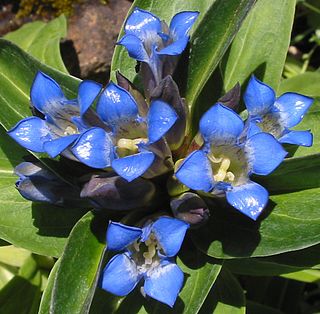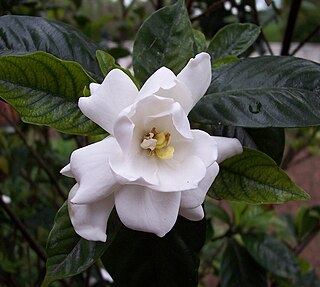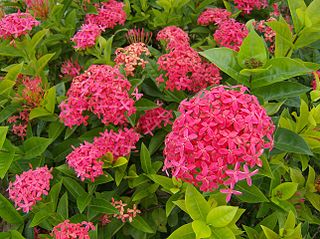
Rubiaceae is a family of flowering plants, commonly known as the coffee, madder, or bedstraw family. It consists of terrestrial trees, shrubs, lianas, or herbs that are recognizable by simple, opposite leaves with interpetiolar stipules and sympetalous actinomorphic flowers. The family contains about 14,100 species in about 580 genera, which makes it the fourth-largest angiosperm family. Rubiaceae has a cosmopolitan distribution; however, the largest species diversity is concentrated in the tropics and subtropics. Economically important genera include Coffea, the source of coffee; Cinchona, the source of the antimalarial alkaloid quinine; ornamental cultivars ; and historically some dye plants.

Uncaria is a genus of flowering plants in the family Rubiaceae. It has about 40 species. Their distribution is pantropical, with most species native to tropical Asia, three from Africa and the Mediterranean and two from the neotropics. They are known colloquially as gambier, cat's claw or uña de gato. The latter two names are shared with several other plants. The type species for the genus is Uncaria guianensis.

Gentianales is an order of flowering plant, included within the asterid clade of eudicots. It comprises more than 20,000 species in about 1,200 genera in 5 families. More than 80% of the species in this order belong to the family Rubiaceae.

Genipa is a genus of trees in the family Rubiaceae. This genus is native to the American tropical forests.

Gardenia is a genus of flowering plants in the coffee family, Rubiaceae, native to the tropical and subtropical regions of Africa, Asia, Madagascar, Pacific Islands, and Australia.

Galium is a large genus of annual and perennial herbaceous plants in the family Rubiaceae, occurring in the temperate zones of both the Northern and Southern Hemispheres. Some species are informally known as bedstraw.

Morinda is a genus of flowering plants in the madder family, Rubiaceae. The generic name is derived from the Latin words morus "mulberry", from the appearance of the fruits, and indica, meaning "of India".

Psychotria is a genus of flowering plants in the family Rubiaceae. It contains 1,645 species and is therefore one of the largest genera of flowering plants. The genus has a pantropical distribution and members of the genus are small understorey trees in tropical forests. Some species are endangered or facing extinction due to deforestation, especially species of central Africa and the Pacific.

Oldenlandia is a genus of flowering plants in the family Rubiaceae. It is pantropical in distribution and has about 240 species. The type species for the genus is Oldenlandia corymbosa.

Canthium is a genus of flowering plants in the family Rubiaceae. They are shrubs and small trees. The leaves are deciduous and the stems are usually thorny.

Vanguerieae is a tribe of flowering plants in the family Rubiaceae and contains 671 species in 29 genera. It is one of the most species-rich groups within the family and it is distributed across the Paleotropics.

Naucleeae is a tribe of flowering plants in the family Rubiaceae and contains about 183 species in 24 genera. Species belonging to Naucleeae occur from Australasia, tropical Asia, Madagascar, tropical Africa, and to the Neotropics and North America.

Plocama is a genus of flowering plants in the family Rubiaceae. It was described by William Aiton in 1789. It is distributed from the Canary Islands to northwestern India.
Cornelis Eliza Bertus Bremekamp was a Dutch botanist.

Ixoroideae is a subfamily of flowering plants in the family Rubiaceae and contains about 4000 species in 27 tribes.

Rubioideae is a subfamily of flowering plants in the family Rubiaceae and contains about 7600 species in 27 tribes.

Spermacoceae is a tribe of flowering plants in the family Rubiaceae and contains about 1346 species in 57 genera. Its representatives are found in the tropics and subtropics.

Gardenieae is a tribe of flowering plants in the family Rubiaceae and contains about 586 species in 53 genera.

Dr. Charlotte M. Taylor is a botanist and professor specialising in taxonomy and conservation. She works with the large plant family Rubiaceae, particularly found in the American tropics and in the tribes Palicoureeae and Psychotrieae. This plant family is an economically important group, as it includes plant species used to make coffee and quinine. Taylor also conducts work related to the floristics of Rubiaceae and morphological radiations of the group. Taylor has collected plant samples from many countries across the globe, including Chile, Colombia, Costa Rica, Panama, and the United States of America, and has named many new species known to science from these regions. As of 2023, Taylor has authored 500 land plant species' names, the third-highest number of such names authored by any female scientist.
Diane Mary Bridson is a British botanist.

















